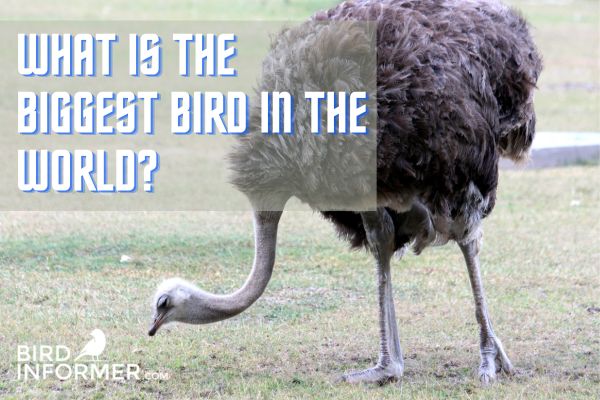Contents
- Understanding Bird Size & Weight
- The Biggest Bird in the World
- Other Big Birds in the World
- Somali Ostrich – Native to the Horn of Africa
- Southern Cassowary – Australian Flightless Bird That Reaches 6 Feet Tall
- Northern Cassowary – Best Known as the One-Wattled Cassowary
- Emu – 2nd Tallest Living Bird after the Ostrich
- Emperor Penguin – The Heaviest and Tallest Penguin Alive Today
- Greater Rhea – A Large Flightless Bird Native to Eastern South America
- Dwarf Cassowary – The Smallest Member of the Living Cassowaries
- Lesser Rhea – Also Known as Darwin’s Rhea, Found in South America
- Andean Condor – The Largest Flying Bird in the World
- Birdwatching Tips for Observing Big Birds
- Conclusion
Were you hoping to discover information about the biggest birds in the world? Birdwatchers are particularly curious about the characteristics of big birds. This information is important to learn, so I’ll share it with you in greater detail below.
The Common Ostrich is the biggest bird in the world by weight. It’s 350 lbs. The Somali Ostrich weighs 285 lbs. Southern Cassowary weighs 190 lbs., Northern Cassowary weighs 170 lbs., and Emu weighs 150 lbs. Emperor penguins weigh 100 lbs., Greater Rhea is 88 lbs., and Domestic Turkeys weigh 86 lbs.
It’s critical to understand the characteristics of big birds because they differ greatly from other small birds with the ability to fly. These characteristics are so critical and important to their survival, which I will fill you in on in greater detail below.
Other topics of discussion include:
- Understanding bird size and weight
- The biggest bird in the world (physical characteristics, unique features, etc.)
- Other big birds in the world and their unique qualities and attributes
- Birdwatching tips for observing big birds
- and more!
Are you ready to learn more about the biggest birds in the world? Keep reading below to discover more about these majestic creatures.
Understanding Bird Size & Weight
Many of the biggest birds in the world cannot fly. Their bodies are heavier, which makes flight difficult or impossible. Plus, they have denser bones, which aren’t conducive to flying.
They’ve developed characteristics that make it possible to escape predators. They have powerful leg muscles, which make it possible to run at high speeds, even though these birds can weigh up to 200-350 pounds on average.
They are also incredibly strong. Their strength gives them the ability to survive predatory attacks because they have powerful bodies that can keep them safe from harm. So, even though they cannot fly in most cases, large birds aren’t incapable of defending or protecting themselves by any means.
To help put Bird size into perspective, please imagine the following:
If a hummingbird were to lay on its stomach and go completely flat, including its feet, it will only measure 2.2 inches in length. On the other hand, if the common ostrich were to lay down the same way as the hummingbird, it would measure a whopping 9 feet and 2 inches!
To continue with this analogy, the Bee hummingbird of Cuba is considered the smallest bird in the world. It’s only 2 inches long, and it weighs 1.5 g. The common ostrich weighs roughly 350 pounds!
Can you see a huge difference? Ostriches and other large birds, including emus, rheas, cassowaries, and others are gigantic when compared to smaller backyard birds that birdwatchers tend to gravitate toward.
The Biggest Bird in the World
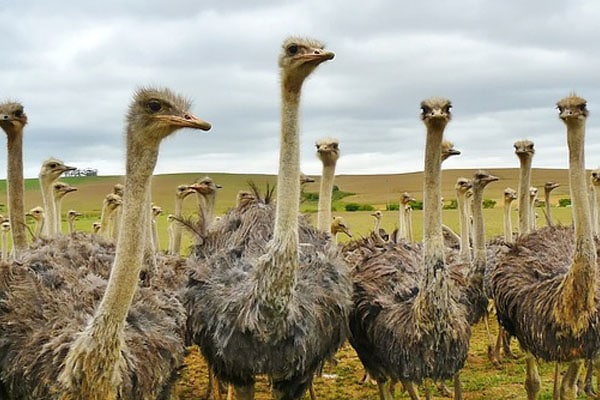
The Common Ostrich is the biggest bird in the world by weight. On average, this behemoth weighs between 345-350 pounds or 156.8 kg. It is truly an impressive creature, to say the least, which is an awesome fact. Believe it or not, it’s so heavy that it can weigh as much as a piano!
According to Discover Wildlife,
The common ostrich, native to large areas of Africa, as well as introduced and feral in parts of Australia, is also the speediest living land bird with running speeds of up to 40 mph, and it lays the largest eggs of any bird.
It’s also the largest bird by height, which is truly impressive. It’s 9 feet and 2 inches long, or 2.8 m. This monstrosity is a record-breaker, to say the least.
The ostrich, whether male or female, has a small head, a beak that is short and wide, and large brown eyes and dark long eyelashes.
Even though this bird cannot fly, it can run incredibly fast. In fact, it is currently considered the fastest bird in the world. It can run up to 40 mph or 70 km/h, which is insanely fast for a bird.
Its long legs are extremely powerful, and it has strong feet as well. Believe it or not, it can actually move 15 feet in a single stride, which is amazing if you ask me.
The ostrich does have wings that it uses, but it doesn’t use them to take flight off the ground. It uses them to keep the ostrich balanced when it’s running at such extremely high speeds. It will hold out its small and short wings and use them to provide balance at high speeds while running along the ground.
It does so much more with its strong legs besides using them to run away from predators. The common ostrich can use its strong legs to defend itself against vicious predators like hyenas, leopards, cheetahs, and lions.
It can kick these predators with such powerful force that it could actually kill them. So, the ostrich’s powerful legs are strong enough to kill, and they have two-toed feet with really sharp claws that can also tear and scratch at predators and prevent them from harming or killing the ostrich.
Ostrich Behavior
According to animalcorner.org,
Ostriches have a nomadic lifestyle and are mostly diurnal, active early and late in the day. They roam around the savannas in groups of 50 birds. Males are territorial and will defend their territory aggressively.
It’s a common myth when you hear that ostriches supposedly bury their heads in the sand. This isn’t the truth at all, by any means. If the ostrich finds itself in a threatening situation, it will either run away or lay very flat on the ground to make itself less noticeable.
Don’t worry, though, because the ostrich is fully capable of defending itself if it does happen to get caught. When caught, it will use its powerful legs to kick its pursuers as hard as it possibly can. Its legs are so strong that they are capable of killing predators while kicking and caring at them with their sharp claws.
If an ostrich is threatened by a predator or rival, it has a unique behavior of using its posture in an effort to intimidate them. The ostrich will fluff its wing feathers and begin to hiss at the predator or rival in question loudly.
Ostriches are fast, as we’ve already mentioned, so it has no problem outrunning hyenas, leopards, lions, and other predators. This bird has strong vocalizations as well. It makes lots of different noises, including snorting, hissing, booming, and whistling sounds.
For example, the booming sound is part of their mating technique. It lets females know that it’s time to meet. On the flip side, the female ostriches will make hissing sounds in return as part of their complicated mating ritual. Males beat their wings in an effort to attract a mate as well, after which it will then drive away potential intruders to their mating ritual.
Have You Ever Seen An Ostrich Run?
Do you know how fast they can go? Click the button below to find out!
Ostrich Habitat
Ostriches inhabit a number of different ecosystems, including open woodlands, desert areas, and the Savannah of southern and central Africa.
These birds that are native to Africa are often found grazing with other large animals, including gazelles, wildebeests, zebras, and giraffes.
Although they are omnivorous creatures, they tend to eat anything that they find available within their habitat. Even more interesting, this large bird consumes less water and food, uses less land, and makes less methane and waste when compared to any other omnivorous animal that eats red meat. So, it doesn’t have a detrimental effect on its overall environment or ecosystem.
Other Big Birds in the World
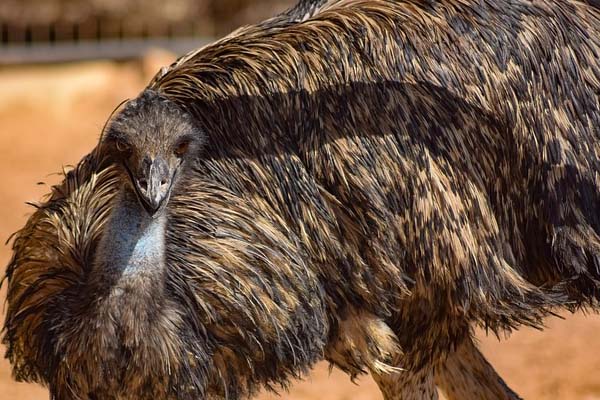
Besides the common ostrich, there are other very big birds still in existence today. Many of these birds range from nearly 300 pounds to 65 pounds, with many other birds that have various weights in between.
They include the following:
- Somali Ostrich
- Southern Cassowary
- Northern Cassowary
- Emu
- Emperor Penguin
- Greater Rhea
- Dwarf Cassowary
- Lesser Rhea
- Andean Condor
Learn more about their physical characteristics, habitat, behavior, and interesting facts.
Somali Ostrich – Native to the Horn of Africa
- Physical Characteristics: Males have long blue necks and heads, large bare blue legs, solid black loose plumage, small wings, and bright white tales. Female Somali ostriches are dark brown.
- Behavior: The Somali ostrich feeds mostly by browsing as opposed to grazing. Their preference is for thicker bushes when compared to the common ostrich. Somali ostriches like to remain hidden within the thick vegetation as opposed to roaming the open plains. They eat lizards, rodents, snakes, and insects, although the majority of their diet consists of vegetation. They have powerful legs, are quite aggressive, and kick with devastating effects.
- Habitat: The Somali ostrich lives in the northern part of Africa, better known as the Horn of Africa. They are exported all over the world, but their natural population in Africa is declining. Their conservation status is Vulnerable but not considered Endangered yet.
Interesting Facts about Somali Ostriches
- It is a large flightless bird
- Its lifespan is 40-45 years
- It can tolerate all types of climates and adapt easily
- Its place of origin is Africa
Southern Cassowary – Australian Flightless Bird That Reaches 6 Feet Tall
- Physical Characteristics: The southern cassowary stands incredibly tall at 5.8 feet in height. Males weigh up to 121 pounds, while their female counterparts can reach weights of 167 pounds because they are the larger of the two species. This bird has a saggy waddle, a brown helmet atop its head, its neck is vivid purple and blue colors, and its eyes are amber. It has sharp claws at the end of three toes that can grow as much as 5 inches long. Its legs are incredibly powerful, which helps it to run at high speeds.
- Behavior: This bird is solitary and territorial, yet it sheds its solitary nature during the breeding season. It remains active throughout the morning and then again in the late afternoon. Occasionally, you’ll even see it active at night when the moonlight shines bright. Otherwise, the southern cassowary is a shy bird but also very aggressive when the time comes to breed.
- Habitat: The habitat of the southern cassowary is on the Australian continent, found in the tropical rainforests to the far North in Queensland. They also prefer mangrove forests and Melaleuca swamps as their ideal stomping grounds.
Interesting Facts about the Southern Cassowaries
- It can run up to 31 mph
- It can jump 7 feet straight up in the air
- Its average lifespan is 40 years in the wild
- According to the San Diego Zoo, “while all birds are descended from dinosaurs, the mysterious cassowary is thought to be more similar to ancient dinosaurs than most other birds. Large bodied with fierce claws, these flightless birds also have casques, a helmet-like structure atop the head, which many dinosaurs are believed to have had.”
Northern Cassowary – Best Known as the One-Wattled Cassowary
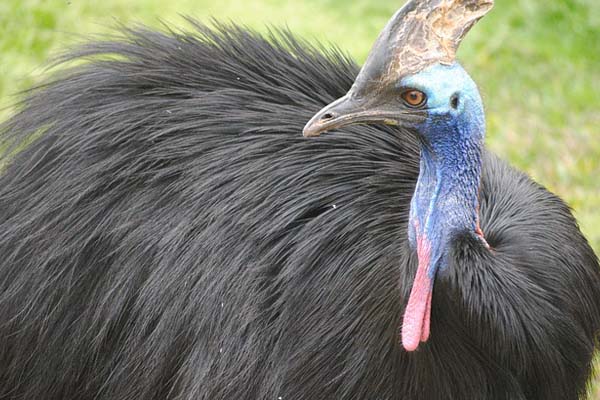
- Physical Characteristics: The plumage of the Northern cassowary is stiff, hard, and black. Its facial skin is blue and purple, which is similar to the southern cassowary; it also has a casque on top of its head. Its feet are enormous, and it has three toes with an inner toe that is large and dagger-like. Males weigh between 66-82 pounds and are smaller than females, who, on average, weigh 128 pounds. They stand for .11-5.11 feet high, and their bill is slightly shorter than that of the southern cassowary.
- Behavior: The Northern Cassowary is also a shy, solitary bird. The bulk of their diet is made up of fruits, berries, lizards, snakes, frogs, rats, mice, and small animals. They also consume snails, small insects, and small birds. If they find dead animals, they will eat them. Adult Northern Cassowary will eat their feces because it often contains undigested fruit. During the breeding season, the female is a polygamist and lays 3-5 green eggs on a nest prepared by a male that keeps it well camouflaged.
- Habitat: The habitat of the Northern cassowary is found in lowland rainforests and coastal swamps along the islands of Salawati, Batanta, Yapen, and northern New Guinea.
Interesting Facts about Northern Cassowaries
- It can run as fast as 31 mph
- It can slice open your skin if kicked by its razor-sharp claws
- Its conservation status is considered Vulnerable, meaning its population is decreasing
- It uses its casque to make a low-frequency booming sound
Emu – 2nd Tallest Living Bird after the Ostrich
- Physical Characteristics: Emus have small wings, their feet have three toes, and their legs are long and powerful, which help propel these flightless birds forward. They have shaggy feathers that droop and are grey and brown in color along their body. The coloration on their neck and head is blue and black.
- Behavior: Emus are curious creatures that are generally domicile, but they might fight with one another on occasion. They make loud booming calls, grunting sounds, and drumming sounds. The male member of the species makes a sound that sounds like he’s saying “e-moo,” which is how they got their name. This loud call can be heard for long distances.
- Habitat: These birds prefer many types of habitats, including tropical woodlands and open arid plains, along with anything in between. They do not like areas that are thickly forested. They are scattered throughout Australia, except they do not live in Tasmania. Found mostly throughout Victoria, they prefer avoiding areas that are densely populated, so they aren’t typically found in central districts.
Interesting Facts about Emus
- It is considered a ratite, which is a large flightless bird
- It has long legs, which gives it the ability to outrun predators and walk long distances
- It is a strong swimmer
- It can run 30 mph
- The emu, along with the kangaroo, is on the Coat of Arms of Australia
Emperor Penguin – The Heaviest and Tallest Penguin Alive Today

- Physical Characteristics: Emperor penguins have small beaks, small flippers, a thick fat reserve, and two layers of feathers to keep the heat trapped and prevent heat loss. Their legs and ankles have feathers on them as well to prevent the Emperor penguin from getting chilly. It stands approximately 3.6 to 4.3 feet tall, and its weight fluctuates dramatically throughout the year between 50-100 pounds.
- Behavior: Emperor penguins are social birds. They nest together and forage together in groups. They also form large nesting colonies, and they like to huddle together when it gets really cold outside. They are active at all times of the day and night, and they like to defend small areas around them and nothing more.
- Habitat: These penguins only live in Antarctica in the wild. They tend to stick to Snow Hill Island, which is located in the Weddell Sea. They never set foot on land and make their colonies on sea ice and like to occupy parts of the frozen sea, where they go to breed.
Interesting Facts about Emperor Penguins
- It is the largest bird of all 18 different penguin species
- Antarctica is home to approximately 595,000 Emperor Penguin adults
- British scientists used satellites to identify colonies of Emperor penguins from space
- Female Emperor penguins lay a single egg, but the male penguin incubates it
Greater Rhea – A Large Flightless Bird Native to Eastern South America
- Physical Characteristics: It has long and muscular legs, weighs up to 88 pounds, and stands 5.5 feet tall. It has a long neck and long legs, and its thighs, neck, and head are all covered in feathers. It does not have any tail feathers. The greater Rhea plumage is typically brown and grey, with underparts that are white. According to the Smithsonian Institution, “Rheas cannot fly, but they have unusually long wings for flightless birds.”
- Behavior: These birds use their really long legs to walk for long distances, and they are also terrestrial birds. Typically, the greater Rhea will not run unless it’s participating in a social activity. One example is trying to impress a mate during the breeding season. Rheas typically become social and flock together during the winter, but the males like to remain solitary during the breeding season in the spring.
- Habitat: The Greater Rhea tends to live in the southeastern portion of South America, including Argentina, Uruguay, Bolivia, Paraguay, and Brazil. It prefers semi-arid scrubland and grassland. While breeding, greater rheas will stay near marshes, lakes, and rivers. You can find them on the lowland and upland plains throughout the majority of South America.
Interesting Facts about Greater Rheas
- Their wings are unusually long for flightless birds, which they use to balance themselves like an airplane rudder
- In South America, they use the feathers of the Greater Rhea to make feather dusters
- The male members of the species incubate the eggs. They also care for their baby chicks once they’ve hatched
- It can run incredibly quickly at 40 mph
Dwarf Cassowary – The Smallest Member of the Living Cassowaries
- Physical Characteristics: They have a helmet-like casque on top of their head, which is shaped triangular early and becomes flat toward the back. They have a black face and head, and their neck is a deep blue color. They have violet and red shoulders, and their feathers are dark black along their body. Their legs are grey-colored, long, and powerful, and they have large feet.
- Behavior: Typically, the door cassowary is a shy bird that usually keeps to itself. If it is threatened, it will kick in/at its attackers using sharp claws. This bird does not have the ability to fly, yet it is a fast runner and a very good swimmer. The bird remains solitary except during breeding season. It’s territorial and is active in the morning and late in the afternoon.
- Habitat: The dwarf cassowary is found mostly on Yapen Island, New Britain, and New Guinea in the mountains. It lives at elevations of 10,800 feet. If it happens to be in an area where no other cassowary species lives, it will populate the lowlands, unless other cassowaries are living there.
Interesting Facts about Dwarf Cassowaries
- Female dwarf cassowaries lay 3-6 green eggs
- The dwarf cassowary has a smaller bill and a much shorter length than other cassowaries
- Its conservation status is classified as Near Threatened, meaning it is very vulnerable to becoming an endangered species in the near future
- It eats small vertebrates like frogs and lizards, plant tissue, insects, and fungi
Lesser Rhea – Also Known as Darwin’s Rhea, Found in South America
- Physical Characteristics: The Lesser Rhea is roughly 3.0-3.3 feet tall and weighs between 33-63 pounds. Its appearance makes it look like a small ostrich. Out of all ratites, the lesser Rhea wings are the largest proportionally to its body. It has long legs, a long neck, grey/brown feathers and white feathers underneath its body.
- Behavior: This bird is very social and forms mixed groups that contain 5-30 members. Males are territorial and aggressive during their mating season. Receptive females tend to cluster together into groups. Males tend to wander off to live a solitary life as they reach old age.
- Habitat: Darwin’s Rhea lives exclusively in Altiplano and Patagonia in the South American open scrublands. This bird ranges across Puna grasslands and the steppes of the Andean plateau. It breeds near rivers, swamps, and lakes and likes to inhabit arid regions.
Interesting Facts about Lesser Rheas
- It feeds on broad-leaf plants, fruits, roots, and seeds
- They typically get their water from the plants that they ingest
- They will also consume lizards, rodents, and insects
- It has very little stamina and runs with its wings folded back
Andean Condor – The Largest Flying Bird in the World
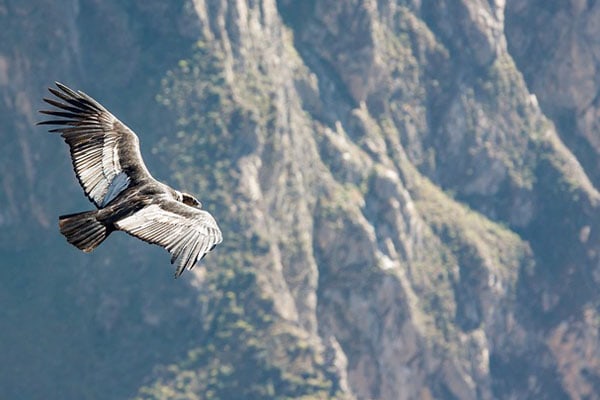
- Physical Characteristics: The Andean Condor has feathers that are mostly black, yet the collar around its neck is made of fluffy white feathers, and on its wings, it also has white patches. Their heads are bald and grayish-red in color. The male Andean Condor has a caruncle on the front of their heads, which is a fleshy lump.
- Behavior: Andean Condors are monogamous birds. When they find a partner, they will meet with them for life. They spend the majority of their time flying, which is impressive since it’s the largest bird capable of flight. It’s active most of the time throughout the day, although they like to roost on shelves and ledges while resting communally. They do not roost communally for breeding purposes, though.
- Habitat: Their habitat consists of the majority of the Andes Mountains on the Pacific Coast region near Western South America. There ranges between Columbia and Northwestern Venezuela. While heading south, they can be found as far south as Tierra del Fuego. They like to live near the coast so they can enjoy ocean breezes, or they’ll live in deserts with strong thermal air currents.
Interesting Facts about Andean Condors
- Out of all raptors, the Andean condor’s wingspan is the largest
- The Andean Condor is the national bird of Columbia, Chile, Ecuador, and Bolivia
- Its wingspan is 10.10 feet
- It can fly 15,000 feet in the air!
| Biggest Birds by Weight | Weight & Height |
|---|---|
| Common Ostrich (Struthio camelus) | 345-350 pounds, 9.2 feet |
| Somali Ostrich (Struthio molybdophanes) | 220-287 pounds, 6.9 to 9 feet |
| Southern Cassowary (Casuarius casuarius) | 121-167 pounds, 5.8 feet |
| Northern Cassowary (Casuarius unappendiculatus) | 82-165 pounds, 4.11 to 5.11 feet |
| Emu (Dromaius novaehollandiae) | 40-154 pounds, 6.2 feet |
| Emperor Penguin (Aptenodytes forsteri) | 50-101 pounds, 3.6 to 4.3 feet |
| Greater Rhea (Rhea americana) | 44-88 pounds, 3.0 to 5.5 feet |
| Dwarf Cassowary (Casuarius bennetti) | 40-75 pounds, 3.5 feet |
| Lesser Rhea (Rhea pennata) | 33-63 pounds, 3.0 to 3.3 feet |
| Andean Condor (Vultur gryphus) | 33 pounds, 3.9 feet |
Birdwatching Tips for Observing Big Birds
Observing big birds is lots of fun, but it’s likely to be different when compared to your typical birdwatching trip in a bird sanctuary or natural habitat. There’s much to think about, including their habitat, behavior, and other potential factors.
Habitat
Unless you intend to visit a farm or protected bird sanctuary, the odds of seeing a large bird in a local park are practically nonexistent. This is especially true if you live in the United States since most large birds live in other countries.
Take the ostrich as an example. They live in semi-arid plains and woodlands throughout Africa. To observe these birds in the wild, you’ll need to go on an African safari in order to visit them in their natural habitat.
Or what about the Greater Rhea? Their home is in southeastern South America in countries including Argentina, Uruguay, Bolivia, Paraguay, and Brazil. Their preferred habitat is semi-arid scrubland and grassland. Viewing these birds in the wild will take a serious commitment on your part, so please keep that in mind.
To see large birds in their natural environment, your best bet might be to sign up for one of the many birding tours that take place throughout South America. There are tours that regularly visit the Galapagos Islands, Chile, Brazil, Ecuador, Argentina, and other countries with large popular birds.
Behavior
Behavior is an important factor to consider when bird watching for large birds in their natural habitat. Many of these large birds have thick and powerful legs that they use to stomp predators to death in some cases. Plus, their feet have thick claws and talons that can shred human skin to ribbons if you aren’t careful.
If you’re going to view large birds like ostriches, cassowaries, rhea, emus, and condors in the wild, you must learn more about these birds and how they might react to your presence if you were to confront them on their territory. They might not appreciate your presence, so you’ll be much better off getting a good pair of binoculars so you can view them from a distance.
Ultimately, I recommend becoming a part of birdwatching tours whenever it’s possible to view large birds. The tour guides will know how to properly prepare you while visiting these humongous birds in their natural environment. If you plan on going it alone, you should definitely learn more about the large birds you intend to bird watch to better learn about their habitats, behaviors, and other important facts.
While you’re at it, you’d certainly benefit from getting a pair of high-quality binoculars, field guides, spotting scopes, cameras, and other beneficial equipment that will approve your overall bird-watching experience.
Conclusion
Thanks for taking the time to read this valuable information about the biggest birds in the world. To recap, the topics we covered in great detail include:
- Information about ostriches, the biggest bird in the world
- Understanding bird weight and size
- Physical characteristics, habitat, and interesting facts about the biggest birds in the world
- Birdwatching tips for observing big birds
As birdwatchers, it’s of the utmost importance to learn more about and understand big birds before you attempt to watch them in close proximity. Not only could potentially be dangerous, but you could also potentially disturb these birds and scare them away from their natural habitats.
Unfortunately, many of these large birds are endangered species, near threatened, or vulnerable to becoming endangered. So, we would never want to potentially put them in harm’s way just to satisfy our curiosity. It’s best to view them from a distance using the latest bird-watching equipment, including digital binoculars, spotting scopes, field guides, and more.
I’d like to encourage all of my readers to continue learning about and observing these amazing and fascinating creatures. It’s always fun to learn about their mating rituals, behaviors, habitats, self-defense tactics, and so much more. Plus, by visiting them in their natural habitat, you have an opportunity to see these majestic birds up close and personal, which is truly a beautiful sight to behold.

